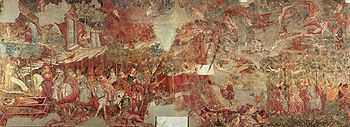Buonamico Buffalmacco
.jpg)

Buonamico di [son of] Martino or Buonamico Buffalmacco (active c. 1315–1336) was an Italian painter who worked in Florence, Bologna and Pisa. Although none of his known work has survived, he is widely assumed to be the painter of a most influential fresco cycle in the Camposanto in Pisa, featuring the The Three Dead and the Three Living, the Triumph of Death, the Last Judgement, the Hell, and the Thebais (several episodes from the lives of the Holy Fathers in the Desert). Painted some ten years before the Black Death spread over Europe in 1348, the cycle - a "painted sermon" (L. Bolzoni) - enjoyed an extraordinary success after that date, and was often imitated throughout Italy. The youngsters' party enjoying themselves in a beautiful garden while Death piles mounds of corpses all around is likely to have inspired the setting of Giovanni Boccaccio's Decameron, written a few years after the Black Death.
Boccaccio (in his Decameron) and Franco Sacchetti (in his Il trecentonovelle) both describe Buonamico as being a practical joker. Boccaccio features Buonamico along with his friends and fellow painters Calandrino and Bruno in several tales (Day VIII, tales 3, 6, and 9; Day IX, tales 3 and 5). Typically in these stories, Buonamico uses his wits to play tricks on his friends and associates: convincing Calandrino that a stone he possesses (heliotrope) confers invisibility (VIII/3), stealing a pig from Calandrino (VIII, 6), convincing the physician Master Simone of an opportunity to ally himself with the devil (VIII, 9), convincing Calandrino that he has become pregnant (IX, 3), convincing Calandrino that a particular scroll can cause a woman to fall in love with him (IX, 5). Throughout the stories, Buonamico is frequently depicted at work painting in the houses of notable gentlemen in Florence but eager to take time to eat, drink and be merry.
Giorgio Vasari includes a biography of Buonamico in his Lives, in which he tells several anecdotes about his comic escapades.[1] Vasari tells of Buonamico's youthful tricking of his master Tafi during his apprenticeship, various pranks and tricks that Buonamico played on his patrons, and his habit of embedding texts within his paintings. Dismissed by Vasari as just another of the witty painter's gags, which his "clumsy" contemporaries had misunderstood and foolishly imitated, the Camposanto frescoes are actually scattered with texts, a possible indication of the veracity of Vasari's remark. In the scroll over the cripple beggars in the center of The Triumph of Death, for instance, it says, "Since prosperity has completely deserted us, O Death, you who are the medicine for all pain, come to give us our last supper."
Vasari discusses various paintings by the artist which no longer exist, and many of which had already perished by the time of Vasari's writing in the sixteenth century. He describes a series of paintings at the convent of Faenza in Florence (already destroyed by the sixteenth century), works for the abbey of Settimo (now also lost), tempera paintings for the monks of the abbey of Certosa (also in Florence), and frescoes in the Badia at Florence. He describes a series of paintings depicting the life of Saint Catherine of Siena in a chapel in her honor in Assisi at the Basilica of Saint Francis (an attribution rejected by later scholars), and several prominent commissions at various abbeys and convents in Pisa. Interestingly, Vasari does not attribute the famed Pisan frescoes now associated with Buonamico to the painter, but rather, credits him with four frescoes at the Camposanto depicting the beginning of the world through the building of Noah's Ark, which later scholars have instead attributed to Piero di Puccio of Orvieto.[2]
Vasari presents conflicting information regarding Buonamico's death, dating it to the year 1340,[3] but also stating that he was still alive in 1351.[4] In any case, he is said to have died at the age of 78, in poverty, and to have been buried at the hospital of Santa Maria Novella, in Florence.[5]
Notes
References
- Vasari, Giorgio; translation by George Bull (1965). Lives of the Artists. Penguin Classics.
External links
See also
| Wikimedia Commons has media related to Buonamico Buffalmacco. |